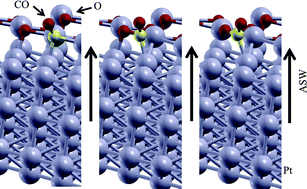The quantum mechanics derived atomistic mechanism underlying the acceleration of catalytic CO oxidation on Pt(110) by surface acoustic waves†
Abstract
Experimental evidence that surface acoustic waves (SAW) can significantly enhance the rate of catalytic oxidation of CO to CO2 over the Pt(110) catalyst surface [S. Kelling et al., Faraday Disc., 1997, 107, 435–444] is examined using quantum mechanics (QM) simulations. First we determined the QM based mechanism for the O2-rich régime of the reaction, and the energy landscape of CO interacting with an O-covered reconstructed Pt(110) surface at both static and dynamic levels, but in the absence of SAW. We then utilized ab initio molecular dynamic (AIMD) simulations to determine how SAW might modify the kinetics. We focus here on the short (picosecond time scale) shock spikes induced by switching of domains in the piezoelectric driver on which the catalyst is deposited. We find that SAW-induced spikes promote dynamic changes in the diffusion and desorption, from which we estimate the influence of SAW on CO oxidation rate over Pt(110). We find good agreement with the experimentally observed catalytic enhancement by SAW. With an atomistic mechanism in place one can now consider how to use SAW to enhance other catalytic reactions.


 Please wait while we load your content...
Please wait while we load your content...